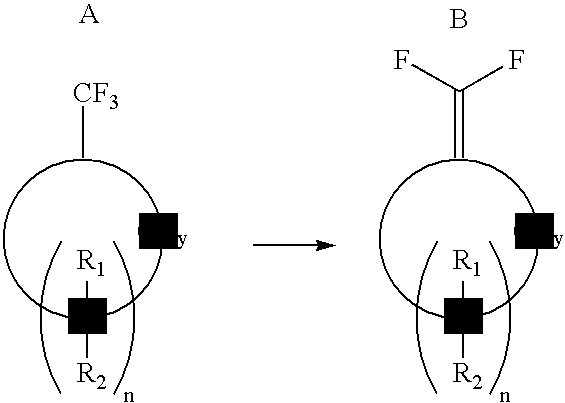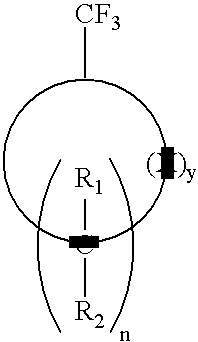Process for producing 1,1-difluorovinyl cycloaliphatic compounds
a technology of difluorovinyl cycloaliphatic compounds and cycloaliphatic compounds, which is applied in the field of process for producing 1, 1difluorovinyl cycloaliphatic compounds, can solve the problems of failure of the same reaction to substitute a ketone for aldehyde, and achieve the effect of high yield
- Summary
- Abstract
- Description
- Claims
- Application Information
AI Technical Summary
Benefits of technology
Problems solved by technology
Method used
Image
Examples
example 1
Synthesis Of 1,1-Difluorovinylcyclohexane Using Lithium Dicyclohexylamide / KtBuO
[0031]A 100 mL 3-neck round bottom flask equipped with a N2 inlet tube, rubber septum and glass stopper was loaded with solid lithium dicyclohexylamide (0.86 g, 4.5 mmol). THF (3 mL), was added via a syringe and the mixture was cooled to −10° C. To this solution, a solution of trifluoromethylcyclohexane (456 mg, 3.0 mmol) in hexane (2 mL) was added drop-wise followed by addition of solid KtBuO (505 mg, 4.5 mmol). The mixture was stirred for 10 min. then brought to RT for 30 min. The reaction was monitored by GCMS for completion. After cooling again to −10° C., the reaction was quenched by addition of water (2 mL), extracted into hexane (10 mL); dried (MgSO4), filtered and the solvent was distilled to obtain the product in 92% yield by GC.
[0032]The results show that the 1,1-difluorovinylcyclohexane was produced. (Mass spectrum: m / e 132 (M+). 19F NMR (CDCl3) d −100 (2F). 1H NMR (CDCl3) d 2.1 (4H, m), 1.5 (4...
example 2
Synthesis Of 1,1-Difluorovinylcyclohexane Using Lithium Diisopropylamide / KtBuO
[0033]Using the apparatus described in Example 1, a solution of lithium diisopropylamide in THF / hexane was prepared from diisopropylamine (0.63 mL, 4.5 mmol) and 2.5M BuLi (1.8 mL, 4.5 mmol) at −50° C. The solution was brought to −10° C. and a hexane solution of trifluoromethylcyclohexane (456 mg, 3.0 mmol in 2 mL) was added followed by addition of KtBuO (505 mg, 4.5 mmol). The mixture was stirred for 10 min. then brought to RT for 30 min. The reaction was monitored by GCMS for completion. After cooling again to −10° C., the reaction was quenched by addition of water (2 mL), extracted into hexane (10 mL); dried (MgSO4), filtered and the solvent was distilled to obtain the product in 97% yield by GC.
[0034]The results show that dehydrofluorination of the trifluoromethyl cyclohexane occurred using the described super base system.
example 3
Synthesis of 1,1-Difluorovinylcyclohexane Using Lithium 2,2-6,6- Tetramethylpiperidide / KtBuO
[0035]Using the apparatus described above a solution of lithium 2,2-6,6-tetramethylpiperidide in THF / hexane was prepared from 2,2-6,6- tetramethylpiperidine (1.0 mL, 6.0 mmol) and 2.5M BuLi (2.4 mL, 6.0 mmol) at −50° C. The solution was brought to −10° C. and a hexane solution of trifluoromethylcyclohexane (456 mg, 3.0 mmol in 2 mL) was added, followed by addition of KtBuO (673 mg, 6.0 mmol). The mixture was stirred for 10 min. then brought to RT for 30 min. The reaction was monitored by GCMS for completion. After cooling again to −10° C., the reaction was quenched by addition of water (2 mL), extracted into hexane (10 mL); dried (MgSO4), filtered and the solvent was distilled to obtain the product in 95% yield by GC.
[0036]The results show that the dehydrofluorination of the trifluoromethylcyclohexane was achieved using the described base.
PUM
| Property | Measurement | Unit |
|---|---|---|
| temperatures | aaaaa | aaaaa |
| temperatures | aaaaa | aaaaa |
| structure | aaaaa | aaaaa |
Abstract
Description
Claims
Application Information
 Login to View More
Login to View More - R&D
- Intellectual Property
- Life Sciences
- Materials
- Tech Scout
- Unparalleled Data Quality
- Higher Quality Content
- 60% Fewer Hallucinations
Browse by: Latest US Patents, China's latest patents, Technical Efficacy Thesaurus, Application Domain, Technology Topic, Popular Technical Reports.
© 2025 PatSnap. All rights reserved.Legal|Privacy policy|Modern Slavery Act Transparency Statement|Sitemap|About US| Contact US: help@patsnap.com


